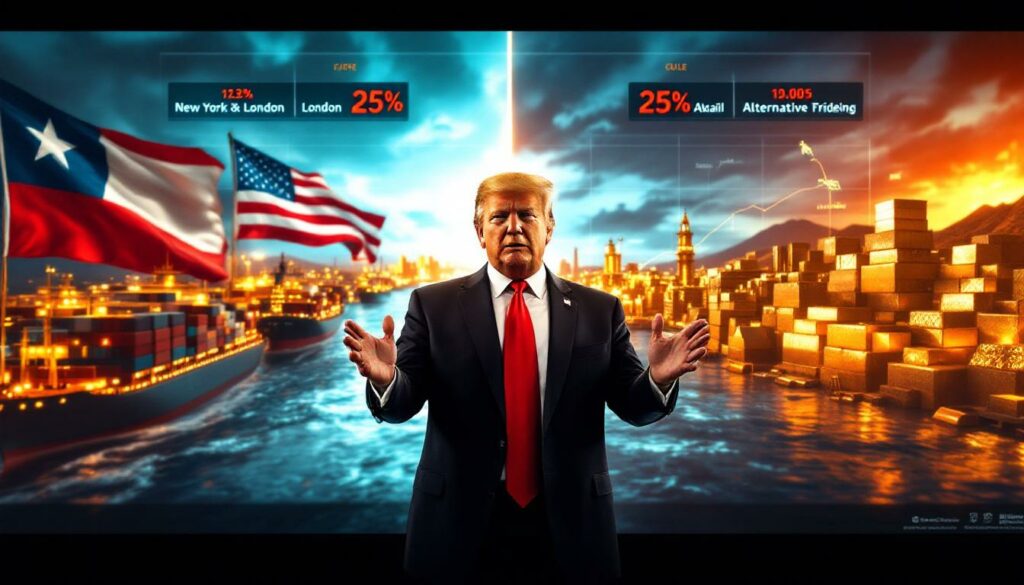What Is Trump's New Copper Tariff Policy?
Understanding the 50% Tariff Announcement
In a dramatic escalation of U.S. trade policy, President Trump announced a 50% tariff on all imported copper via his Truth Social platform on July 9, 2025. The announcement sent shockwaves through global metal markets, with implementation scheduled for August 1, 2025—giving traders and importers just over three weeks to adjust their strategies.
The 50% rate significantly exceeded market expectations, representing one of the most aggressive trade actions on industrial metals in recent history. This copper-specific tariff follows Trump's earlier protectionist measures targeting steel and aluminum, establishing a clear pattern of escalating trade barriers in the industrial metals sector.
"This tariff is designed to protect American copper producers and revitalize domestic mining operations that have struggled against foreign competition," Trump stated in his announcement, though specific details about implementation mechanisms remain limited.
Industry analysts note that the 50% figure is particularly striking—nearly double what many market participants had anticipated based on previous metals tariffs, which typically ranged from 10% to 25%.
Historical Context of US Metal Tariffs
The copper tariff announcement represents the culmination of a process that began months earlier with Trump's initial tariff proposal on copper in February 2025. That preliminary announcement had already triggered significant market repositioning, but the finalized 50% rate represents a more aggressive stance than initially indicated.
This latest measure builds upon Trump's established pattern of using tariffs as a central trade policy tool. Previously imposed tariffs on steel (25%) and aluminum (10%) created precedent for industrial metal trade barriers, though the copper tariff represents a substantial escalation in both scope and rate.
The copper industry faces a fundamentally different global supply landscape than steel and aluminum, with U.S. dependency on imports significantly higher. The United States currently imports approximately 35% of its refined copper needs, primarily from Chile, Canada, and Mexico, making the market particularly sensitive to tariff uncertainties.
Unlike previous metal tariffs that included country-specific exemptions, the initial announcement made no mention of carve-outs for allies or trading partners with existing agreements, creating considerable uncertainty about universal application.
How Is the Copper Market Responding to the Tariff News?
Immediate Price Impact
The market reaction to Trump's announcement was swift and dramatic. New York copper futures surged to a premium of approximately 25% over London Metal Exchange (LME) prices within 24 hours of the announcement, creating significant arbitrage opportunities for traders positioned to capitalize on the price differential.
Notably, this premium remains below the full 50% tariff rate, reflecting market uncertainty about whether the tariff will be applied universally or if exemptions will eventually be granted to certain countries or product categories. This pricing discrepancy represents a calculated bet by market participants that implementation may be less comprehensive than announced.
The copper market, typically characterized by relatively stable global pricing, has effectively split into distinct regional markets, with U.S. prices significantly detached from international benchmarks. This regionalization threatens to disrupt global supply chains and complicate price discovery mechanisms that have functioned efficiently for decades.
Trading volumes on both the COMEX and LME have reached record levels as market participants scramble to reposition ahead of the August 1 implementation date, with volatility measures hitting multi-year highs. Many analysts are now revising their copper price prediction models to account for this new market reality.
Supply Chain Disruptions
The announcement has triggered a massive reshuffling of global copper flows, with market participants estimating U.S. copper inventories will reach approximately 500,000 metric tons by the implementation date—a historic level representing several months of U.S. industrial consumption.
Nearly half of this inventory is concentrated in New Orleans, a traditional storage hub for COMEX deliverable copper, with Panama City Port in Florida emerging as a secondary storage location as warehousing capacity tightens. This rapid inventory build threatens to overwhelm logistical infrastructure in key ports.
"We're seeing unprecedented movement of material into U.S. warehouses," noted a logistics specialist at a major U.S. port. "Storage capacity is becoming a genuine concern as more vessels are rerouted to beat the deadline."
While the U.S. accumulates stockpiles, other regions are experiencing increasingly severe supply shortages as material is diverted toward American shores. Asian markets, particularly China as the world's largest copper consumer, face tightening physical supply and potential manufacturing disruptions as a result.
The divergence in regional availability is creating a bifurcated global market that threatens to undermine the copper industry's carefully balanced supply chains and potentially disrupt manufacturing operations worldwide.
What Strategies Are Traders Using to Beat the Tariff Deadline?
Alternative Shipping Destinations
Traders have devised creative solutions to overcome the logistical challenges presented by the short implementation timeline. Hawaii has emerged as a strategic delivery point, with shipping times from Asia approximately 10 days compared to over 30 days to mainland destinations like New Orleans.
At least one trader has already completed a copper shipment to Hawaii, establishing a precedent that others are rushing to follow. Since Hawaii falls within U.S. customs territory, copper delivered there before August 1 would presumably avoid the 50% tariff while still being available for domestic consumption.
Similarly, Puerto Rico has become an attractive destination for South American producers, offering a geographically advantageous delivery point that still falls within U.S. tariff boundaries. The island's proximity to major copper-producing nations like Chile and Peru creates a natural transit advantage.
These alternative destinations highlight the geographical creativity being employed in the rush to beat the deadline, with traders leveraging U.S. territories as strategic waypoints to overcome the time constraints imposed by the short implementation window.
Premium Pricing Strategies
Amid the scramble for material, traders are paying approximately $400 per metric ton above LME prices to secure copper brands that meet COMEX contract delivery conditions. This premium represents both the urgency of beating the deadline and a strategic hedge against potential difficulties finding end buyers.
By focusing on COMEX-deliverable brands, traders create a fallback option to deliver material against exchange contracts if direct buyers cannot be secured. This strategy provides important risk mitigation in an increasingly uncertain market environment.
Market sources report that shipments originally destined for other markets, including China, are being diverted mid-voyage to American ports as traders calculate that the premium available in the U.S. market outweighs contract penalties for non-delivery to original destinations.
The resulting bidding war for available copper has created spot market conditions not seen since the commodities supercycle peak, with physical premiums reaching historic levels across major trading hubs. According to Mining.com, this unprecedented situation has led copper prices to soar to record highs in recent days.
Race Against the Clock
With standard shipping times from Asia to New Orleans exceeding 30 days, cargoes initiated after the July 9 announcement face significant risks of arriving after the August 1 implementation date. This timing constraint has created a frenzied atmosphere as traders employ every available tactic to accelerate deliveries.
Industry participants are closely analyzing previous U.S. metal tariff implementations, which typically included exemptions for shipments already in transit when the tariff was announced. However, without explicit confirmation from U.S. authorities, traders remain reluctant to rely on such exemptions materializing.
The clock-based pressure has led to expedited loading operations at major copper ports in Chile and Peru, with reports of premium payments for accelerated handling and priority berth access. Some traders are reportedly chartering dedicated vessels rather than relying on scheduled liner services to gain greater control over transit times.
"Every day counts in this environment," explained a copper trader based in Singapore. "The difference between July 31 and August 1 delivery could mean millions in tariff costs for larger shipments."
The logistical constraints have effectively created a temporary sellers' market for vessels and port services, with freight rates for copper shipments to U.S. destinations increasing by 15-20% in the days following the announcement.
How Are Global Copper Producers Responding?
Chilean Mining Companies' Reaction
In Chile, the main supplier of copper to the U.S. market, mining companies have been holding emergency meetings to discuss prioritizing shipments to American destinations before month-end in July. These producers face complex decisions balancing existing customer commitments against the opportunity to capture premium pricing in the pre-tariff window.
Major Chilean producers, which account for approximately 28% of global copper production, are working with logistics providers to identify available vessel capacity and accelerate loading operations at key ports like Antofagasta and San Antonio. The coordination effort represents an unprecedented mobilization of the Chilean mining sector.
Producers with diversified customer bases face particularly difficult decisions about allocating limited pre-deadline shipping capacity among competing buyers. Long-standing relationships with Asian and European customers are being tested against the immediate financial incentives of prioritizing U.S.-bound material.
The situation has created tension between commercial and operational departments within major mining companies, as sales teams push for maximum U.S. allocation while production planners highlight the complexities of rapidly redirecting established supply chains. These challenges are compounded by recent copper demand surge in various global markets.
Supply Chain Reorganization
Beyond immediate shipment prioritization, producers are evaluating longer-term contract obligations and potential supply reallocation strategies for the post-implementation environment. Uncertainty about which specific copper products will be subject to tariffs complicates this planning process.
While cathode (refined copper) appears certain to fall under the tariff's scope, questions remain about treatment of concentrates, blister copper, and various semi-fabricated products like wire rod and tube. This product-specific uncertainty makes comprehensive supply chain reorganization challenging.
Producers with U.S. downstream processing capacity are exploring options to ship raw material or intermediate products that might face lower tariff rates or qualify for processing exemptions, though such strategies remain speculative without detailed implementation guidelines.
The geographic restructuring of global copper flows will likely extend well beyond the immediate pre-tariff rush, potentially creating lasting changes to established trading patterns and regional price relationships. The global copper supply forecast will need significant revision in light of these dramatic market changes.
What Are the Potential Long-Term Market Implications?
Price Dynamics and Market Structure
The 50% tariff, if fully implemented and maintained, would effectively create a permanent two-tier global copper market with U.S. prices structurally higher than international benchmarks. This price divergence would have profound implications for the metal's role as a global economic indicator and complicate hedging strategies for industrial consumers.
American manufacturers using copper inputs would face significantly higher raw material costs than international competitors, potentially undermining competitiveness in export markets for finished goods containing substantial copper content. Industries particularly exposed include electrical equipment, construction, transportation, and consumer electronics.
"This tariff fundamentally changes the economics of copper-intensive manufacturing in the United States," commented an industry analyst specializing in industrial metals. "The ripple effects through supply chains will be substantial and long-lasting."
Domestic U.S. copper producers would likely benefit from the tariff protection, potentially accelerating development of marginal mining projects that were previously uneconomic at global market prices. However, the U.S. currently produces only about 8% of global copper mine output, with limited short-term capacity to increase domestic supply.
Investment and Industry Impact
The copper tariff creates significant uncertainty for international mining companies with U.S. exposure, potentially influencing future capital allocation decisions and project development timelines. Investment in mining capacity outside the United States may be prioritized to serve markets unaffected by the tariff.
Financial markets are likely to reassess valuation models for copper-exposed companies, with analysts integrating tariff impacts into earnings projections and recalibrating risk premiums to account for increased trade policy uncertainty. Consequently, investors are exploring new copper investment strategies to navigate this changed landscape.
The tariff may accelerate reshoring initiatives in manufacturing sectors that have historically relied on global supply chains, as the economics of domestic production improve relative to imports of copper-intensive components and finished goods.
Longer-term, the tariff could influence technological development and material substitution efforts, potentially accelerating research into aluminum or other alternative materials for applications where copper's superior conductivity properties are not essential.
What Uncertainties Remain About the Tariff Implementation?
Scope and Application Questions
Significant questions remain about the scope and application of the tariff, creating substantial business planning challenges for market participants. The announcement mentioned "imported copper" without specifying product categories, grades, or potential exemptions.
Key unresolved issues include whether the tariff will apply to:
- Copper concentrates and other pre-refined materials
- Scrap and recycled copper
- Semi-fabricated products like wire, tube, and rod
- Copper alloys containing varying percentages of the metal
- Products with copper as a component rather than primary material
The treatment of in-transit shipments also remains uncertain, though precedent from previous metal tariffs suggests potential exemptions for material already at sea when the announcement was made. Without explicit confirmation, however, traders remain hesitant to rely on such exemptions.
Legal and Trade Policy Considerations
The tariff announcement raises complex legal and trade policy questions that remain unresolved. The measure's compliance with World Trade Organization (WTO) obligations and existing free trade agreements like USMCA (with Canada and Mexico) creates potential grounds for challenge.
Market participants anticipate potential legal challenges from affected countries or companies, which could delay or modify implementation. Previous U.S. metal tariffs faced similar challenges with varying outcomes, creating precedent that may influence litigation strategies.
The possibility of negotiated exemptions for certain countries remains open, with diplomatic efforts likely underway from major copper-exporting nations seeking preferential treatment. Such exemptions, if granted, would significantly impact market dynamics and potentially create arbitrage opportunities through transshipment.
"The devil is in the details with tariff implementation," noted a trade policy expert. "Initial announcements rarely capture the complexity of the final regulatory framework, which often includes various exceptions and technical provisions."
The administration has not yet specified which agency will oversee implementation or what documentation requirements will apply, creating additional uncertainty for importers navigating compliance requirements.
FAQ About the Copper Tariff Situation
When exactly will the 50% tariff take effect?
The tariff is scheduled to take effect on August 1, 2025, based on the announcement made on July 9, 2025. This gives market participants a narrow window of approximately three weeks to complete shipments before implementation. The official implementation will likely be formalized through a presidential proclamation and published in the Federal Register before the effective date.
Which copper products will be subject to the tariff?
While the announcement indicated a broad application to "imported copper," specific details about product categories, grades, and potential exemptions remain unclear. Market participants anticipate the tariff will apply to refined copper cathode at minimum, but questions remain about concentrates, scrap, semi-fabricated products, and copper-containing goods. Clarification is expected through implementing regulations before August 1.
Will shipments already in transit be subject to the tariff?
Based on previous U.S. metal tariff implementations, there may be exemptions for shipments already at sea when the tariff was announced, but official confirmation is pending. Market participants are closely watching for guidance from U.S. Customs and Border Protection on this critical question. The standard precedent in tariff implementation typically considers the date of import rather than the shipping date.
How might this affect copper prices for U.S. manufacturers?
U.S. manufacturers using copper inputs will likely face significantly higher material costs, potentially up to 50% more than international competitors, unless they secure domestic supply. This cost differential could undermine competitiveness, particularly for export-oriented manufacturers with copper-intensive products. Companies may explore passing costs to consumers, redesigning products to reduce copper content, or relocating production outside the U.S.
Could other countries implement retaliatory tariffs?
Major copper-exporting nations may consider implementing countermeasures or filing complaints through international trade organizations in response to the U.S. tariff. Chile, Peru, and Canada, as significant copper suppliers to the U.S. market, would be particularly motivated to seek remedies. Historical precedent from previous metal tariffs suggests retaliatory measures often target politically sensitive U.S. exports unrelated to the original tariffed product.
Further Considerations for Copper Market Participants
Adaptive Strategies for Different Market Segments
Different segments of the copper value chain face unique challenges and opportunities from the tariff situation. Mining companies must balance short-term revenue optimization against long-term customer relationships, while traders navigate unprecedented price volatility and logistical complexities.
Downstream fabricators and end-users in the U.S. face perhaps the most significant challenges, needing to secure supply while managing dramatic input cost increases. These companies should consider:
- Evaluating contract structures to include tariff adjustment mechanisms
- Exploring domestic sourcing options despite limited U.S. production capacity
- Assessing product redesign opportunities to reduce copper intensity
- Analyzing the potential for tariff exemption requests based on product uniqueness or national security considerations
Monitoring Implementation Developments
The evolving nature of tariff implementation means market participants must establish robust monitoring systems for regulatory announcements and clarifications. Key sources to track include:
- U.S. Customs and Border Protection guidance documents
- Department of Commerce notices regarding potential exemption processes
- Trade Representative statements on country-specific negotiations
- Industry association interpretations and advocacy positions
The historical pattern with complex tariff implementations suggests initial announcements are often modified through subsequent regulatory guidance, creating both risks and opportunities for prepared market participants.
Longer-
Searching for the Next Major Mineral Discovery?
Stay ahead of the market with Discovery Alert's proprietary Discovery IQ model, which instantly notifies investors of significant ASX mineral discoveries and transforms complex data into actionable insights. Visit our dedicated discoveries page to understand why major mineral discoveries can lead to substantial market returns and begin your 30-day free trial today.




